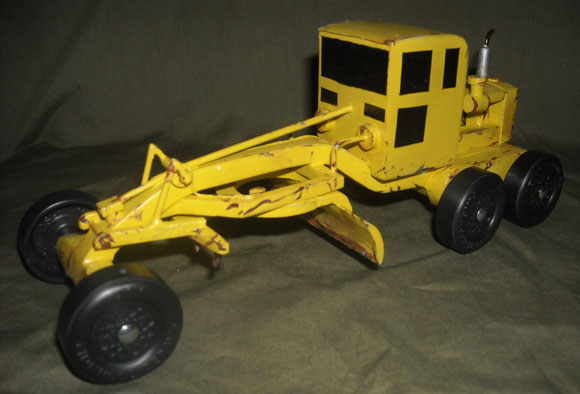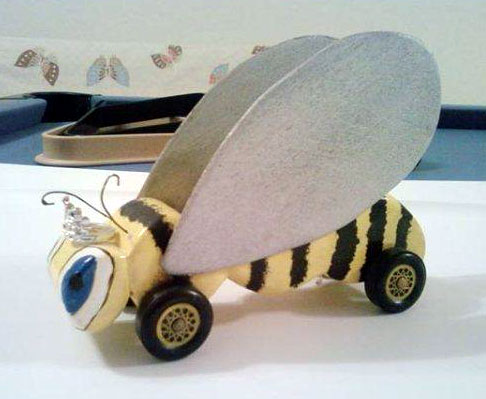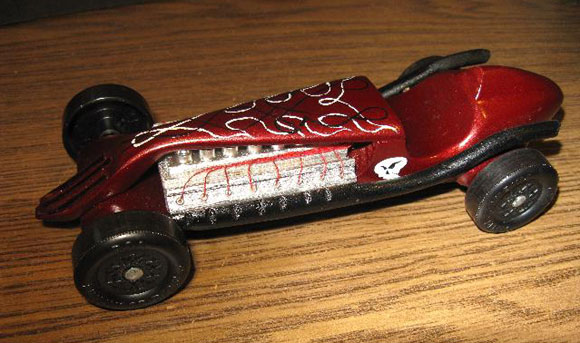– Shop Talk – Drilling With Accuracy
– Pinewood Derby Car Showcase
– Q&A
Shop Talk
Drilling With Accuracy
If you were reading a book and the phrase “drill bit” was used, what mental image would you conjure up? Most people would think of a standard high-speed steel (HSS) drill bit that is part of the drill bit set in most people’s toolbox. This type of drill bit is certainly the most popular, but it is not the best drill bit choice for many woodworking tasks.
Today, we will discuss the various drill bit types available for woodworking, and how they apply to pinewood derby cars.
Regardless of the drill bit type, make sure to know the chuck size of your drill. The chuck size determines the maximum shaft diameter of the drill bit that can be used. Most drills today have a 1/2 inch chuck, but there are some drills that have a 3/8 inch chuck. If your drill has a 3/8 inch chuck, make sure to purchase bits with a shaft no larger than 3/8 inch.
Drill Bit Types
For woodworking, you will find the following drill bit types at your local hardware store:
Forstner – Produces a flat-bottomed, clean edged hole with no chipping. The center point ensures that the hole is drilled where desired. For drilling holes over 7/16 inch, Forstner Bits are generally a better value than Brad Point bits. Some Forstner bits have a saw tooth edge (as seen in the photo) while others do not. Either type works well for pinewood derby use.
Forstner bits are commonly used for creating wheel wells for attaching to the side of a pinewood derby block. They are also used for creating holes for tungsten rounds.
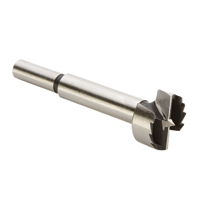
Photo Source: www.rockler.com
Brad Point – Produces a clean edged hole will no chipping. The center point ensures that the drill bit doesn’t wander. For drilling holes between 1/8 and 7/16 inch, Brad Point bits are usually a better value than Forstner bits and do a better job than HSS bits.
Brad Point bits are commonly used for drilling weight holes in pinewood derby blocks
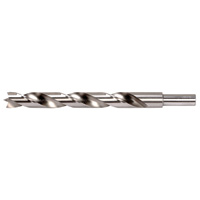
Photo Source: www.rockler.com
Auger – Produces a clean, accurate hole. The screw tip causes the bit to “power feed”, and the auger shape helps in chip removal, so this type of bit is beneficial for drilling very deep holes.
Although Auger bits can be used for pinewood derby cars, Brad Point or Forstner bits are usually a better choice. The screw tip on the Auger bit is not desirable for pinewood derby cars as it makes the hole too deep, and the power feed action can be a bit unwieldy for novice woodworkers.
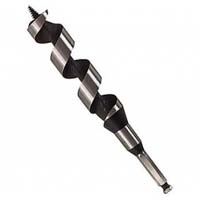
Photo Source: www.toolbarn.com
HSS – A general purpose drill bit for use in wood, metal, plastic, etc. Especially in larger sizes, HSS bits often chip the edge of the hole, and can “wander”. But for holes in a pinewood derby block under 1/8 inch, these are the only real choice.
To minimize chipping, keep the drill speed high, but the feed speed low. To minimize drill bit wander, make a small dimple in the wood at the drilling location with a nail or a punch.
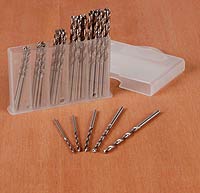
Photo Source: www.rockler.com
Spade – Also known as a “Paddle Bit” this type of inexpensive bit is used for rough boring. Typically they are used in carpentry where a clean hole is not necessary. I strongly recommend avoiding Spade Bits for pinewood derby use.
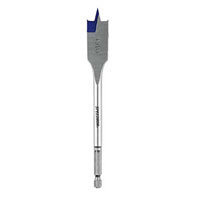
Photo Source: www.drillspot.com
Pinewood Derby Car Showcase
Road Grader – Rob Knapp
This is my 2009 Pinewood Derby car, entered in the adult division. As a Cub Scout Den leader, I try to show the boys what is possible to build from a block of wood. This road grader started life as an official BSA kit. The grader is all wood except for a few pieces of copper wire and part of a pop can I used for the cab roof overhang. This was a very challenging build, but I think the results are favorable.
Queen Bee – William Lund
Every year my boys were in Cub Scouts I had to build extra cars for my daughter and me to race in the Open class. Well, one year my mother- in-law wanted a car to race. I thought and thought … then I remembered that I had always called her “The Queen Bee” of the family. So I went to work making her a car. I cut the shape on a band saw, added a little extra wood to the top to make the body of the bee taller. I hand-sanded the round shapes, found some balsa wood for the wings, added the antennae and crown, and painted it to look like a bee. It was the hit of the pinewood derby. It did not win, but came in second in all of its races — I couldn’t let my mother-in-law’s car beat mine!
Hot Wheels – Randal Veenker
It was my last year as Cubmaster of my pack. I ran the pinewood derby race for the pack as well as being the chairman for our district race. I wanted to have a show car for the last pack race in the open class. I found a Hot Wheels car that gave me the inspiration for this car. It was a looker as well as fast, but not quite fast enough to win.
Q&A
Do you have any tips for beveling back the head of an Awana axle (kind of file, speed of drill press, how to hold the file, etc.)?
Use a medium speed, and a mini-file. If you dip the file in water, it will cut nicer – just make sure to dry off the file thoroughly when complete.
Only a very slight angle is needed. The resulting bevel should be virtually undetectable by the human eye. I am guessing about three degrees.
Note that the file cuts on a push stroke, not a pull stroke. So orient the file so that the axle material is rotating towards the file handle.
I’m considering buying a scroll saw to help in carving cars. Few of the parents in our Awana club have access to power tools so we do the rough shaping on most of the cars using a jig saw, belt sander, and Dremel tool. Is there a better tool than a scroll saw? Do you have any advice about what to look for in a scroll saw? Do you have any tips for using one (besides being extra careful to not cut off a finger)?
A Band Saw is a much better tool for cutting cars. A scroll saw has a very fine blade and is intended for fine scroll work.
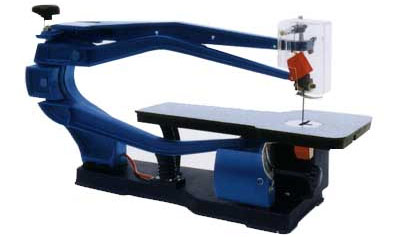
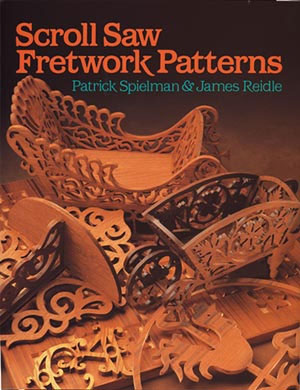
A band saw has a wider blade, so it can cut through thicker material much easier. It is more dangerous than a scroll saw, so more care needs to be taken.
I would suggest a bench mount Jet, Delta, or Craftsman band saw (avoid buying a cheap import). You should be able to get one for under $200. Make sure the one you get will support a 3/8 inch blade. Anything smaller is too small for most pinewood derby work.
Although this one is too small for my taste, here is a Sears 9inch model for just over $100. It will take a 3/8 inch blade. I recommend purchasing a fence for it. That allows you to make accurate straight cuts, and with a jig make accurate angled cuts (think of a Wedge pinewood derby car).
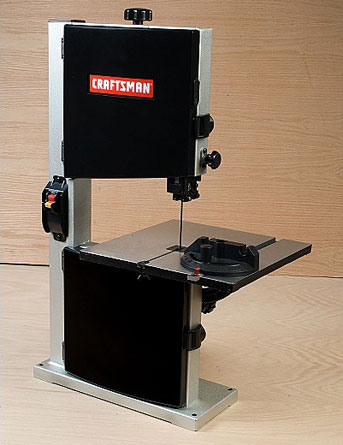
I use a 14 inch Jet, which is much more durable. If you plan to only use it occasionally, then the Sears would be fine. But if you plan to use the band saw on a regular basis, get a larger one (14 inch).
Our Cub Scout District does not allow graphite or oils of any kind. I overheard one racer talking about waxing his axle and wheel hub. Have you ever experimented with wax? What kind? Also, what do you think of spray silicone? When the propellent dries there is no trace of anything. The white powder we’re told to use is terrible. Any suggestions you might have would be most appreciated.
Silicon spray works well, but doesn’t last long enough to be effective. Some waxes work well for the wheel bore – we offer one. If you can’t use graphite, then you could put the wax on the axle as well.
By the way, Boron Nitride is a white powder lube that works much better than the “Dry-White” you refer to (which is powdered Teflon). However, it may be a bit difficult to find.
Want Answers?
Do you have a pinewood derby-related question? If so, e-mail us your question.We answer all questions by e-mail, but not every question will appear in the Q&A section of the newsletter.
Back Issues
Are you a new subscriber, or have you missed some of the previous newsletters? Don’t miss out; all of the issues for Volume 5 through Volume 17 are posted on our web site.
Newsletter Contributions
We welcome your contributions. If you would like to contribute an article, a web site review, a speed tip, or a pinewood derby memory, please e-mail us.
Subscription Information
The Pinewood Derby Times is a free e-newsletter focused on pinewood derby racing. It is published biweekly from October through March.
If you haven’t already done so, please forward this issue to your pinewood derby friends. But please don’t subscribe your friends. Let them decide for themselves. Thanks.
If this newsletter was forwarded to you, why not subscribe to receive this newsletter. There is no cost, and your e-mail address is safe, as we never sell or share our distribution list.
To subscribe, send a blank e-mail to
[email protected]
You will receive a confirmation e-mail. Reply to the confirmation e-mail and you will start receiving the Pinewood Derby Times with the next issue.
Randy Davis, Editor, Pinewood Derby Times
E-Mail: [email protected]
(C)2018, Maximum Velocity, Inc. All rights reserved. Please do not reprint or place this newsletter on your web site without explicit permission. However, if you like this newsletter we grant permission, and encourage you to e-mail it to a friend.
Maximum Velocity disclaims any personal loss or liability caused by utilization of any information presented in this newsletter.
The Pinewood Derby Times is not specific to, and is not affiliated with the Boy Scouts of America, YMCA, Awana, or any other organization.
(R)Maximum Velocity is a registered trademark of Maximum Velocity, Inc.
(R)Pinewood Derby is a registered trademarks of the Boys Scouts of America.
(R)Awana is a registered trademark of Awana Clubs International.
All other names are trademarks of their respective owners.

